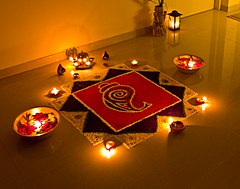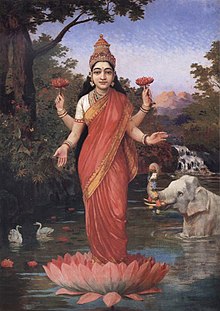Happy Diwali Images Premium Images
diwali images
| diwali / Deepavali | |
|---|---|

Rangoli decorations, made using coloured powder or sand, are popular during diwali.
| |
| Also called | Deepavali |
| Observed by | Hindus, Sikhs, Jains and Newar Buddhists |
| Type | Cultural, seasonal, religious |
| Celebrations | Diya and lighting, home decoration, shopping, fireworks, puja (prayers), gifts, performing religious rituals, feast and sweets |
| Begins | Dhanteras, two days before diwali |
| Ends | Bhai Dooj, two days after diwali |
| Date | Varies per Hindu calendar |
| 2017 date | 19 October (Thursday) 18 October (Wednesday) in South India |
| Related to | Kali Puja, Galungan, diwali (Jainism), Bandi Chhor Divas, Tihar, Swanti |
diwali or Deepavali is the Hindu festival of lights celebrated every year in autumn in the northern hemisphere (spring in southern hemisphere).[3][4] It is an official holiday in Fiji, Guyana, India,[5] Malaysia, Mauritius, Myanmar, Nepal, Singapore, Sri Lanka, Suriname, Trinidad and Tobago, and recently Sindh Province in Pakistan. One of the most popular festivals of Hinduism, it spiritually signifies the victory of light over darkness, good over evil, knowledge over ignorance, and hope over despair.[6][7][8] Its celebration includes millions of lights shining on housetops, outside doors and windows, around temples and other buildings in the communities and countries where it is observed.[9] The festival preparations and rituals typically extend over a five-day period, but the main festival night of diwali coincides with the darkest, new moon night of the Hindu Lunisolar month Kartika in Bikram Sambat calendar (the month of Aippasi in Tamil Calendar). In the Gregorian calendar, diwali night falls between mid-October and mid-November.
Before diwali night, people clean, renovate, and decorate their homes and offices.[10] On diwali night, people dress up in new clothes or their best outfit, light up diyas (lamps and candles) inside and outside their home, participate in family puja (prayers) typically to Lakshmi – the goddess of fertility and prosperity. After puja, fireworks follow,[11] then a family feast including mithai (sweets), and an exchange of gifts between family members and close friends. Deepavali also marks a major shopping period in nations where it is celebrated.[12]
The name of festive days as well as the rituals of diwali vary significantly among Hindus, based on the region of India. In many parts of India,[13] the festivities start with Dhanteras (in Northern and Western part of India), followed by Naraka Chaturdasi on second day, Deepavali on the third day, diwali Padva dedicated to wife–husband relationship on the fourth day, and festivities end with Bhai Doojdedicated to sister–brother bond on the fifth day. Dhanteras usually falls eighteen days after Dussehra.
On the same night that Hindus celebrate diwali, Jains celebrate a festival also called diwali to mark the attainment of moksha by Mahavira, Sikhs celebrate Bandi Chhor Divas to mark the release of Guru Hargobind from a Mughal Empire prison, and Newar Buddhists, unlike the majority of Buddhists, celebrate diwali by worshipping Lakshmi.[
Etymology
diwali festivities include a celebration of sights, sounds, arts and flavors. The festivities vary between different regions.
| |||||||||
diwali (English: /dɪˈwɑːliː/) or Sanskrit dīpāvali means "series of lights", and is derived from dīpam "light, lamp" and oli "glow of light". diwali is also known as dīpotsavam "festival of lights".
The holiday is known as dipawoli in Assamese: দীপাৱলী, dipaboli or dipali in Bengali: দীপাবলি/দীপালি, divāḷi in Gujarati: દિવાળી, divālī in Hindi: दिवाली, dīpavaḷi in Kannada: ದೀಪಾವಳಿ, Konkani: दिवाळी, Malayalam: ദീപാവലി, Marathi: दिवाळी, dipābali in Odia: ଦିପାବଳୀ, dīvālī in Punjabi: ਦੀਵਾਲੀ, diyārī in Sindhi: दियारी, 'tīpāvaḷi in Tamil: தீபாவளி, and Telugu: దీపావళి, Galungan in Balinese and Swanti in Nepali: स्वन्ति or tihar in Nepali: तिहार.
History
diwali dates back to ancient times in India, as a festival after the summer harvest in the Hindu calendar month of Kartika. The festival is mentioned in Sanskrit texts such as the Padma Purana, the Skanda Purana both completed in second half of 1st millennium AD but believed to have been expanded from a core text from an earlier era. The diyas (lamps) are mentioned in Skanda Purana to symbolically represent parts of the sun, the cosmic giver of light and energy to all life, who seasonally transitions in the Hindu calendar month of Kartik.
Hindus in some regions of India associate diwali with the legend of Yama and Nachiketa on Kartika amavasya (diwali night).[23]The Nachiketa story about right versus wrong, true wealth versus transient wealth, knowledge versus ignorance is recorded in Katha Upanishad composed in 1st millennium BC.[24]
King Harsha in the 7th century Sanskrit play Nagananda mentions Deepavali as Deepapratipadutsava (Deepa = light, pratipada= first day, utsava = festival), where lamps were lit and newly engaged brides and grooms were given gifts. Rajasekharareferred to Deepavali as Dipamalika in his 9th century Kavyamimamsa, wherein he mentions the tradition of homes being whitewashed and oil lamps decorating homes, streets and markets in the night.[25] The Persian traveller and historian Al Biruni, in his 11th century memoir on India, wrote of Deepavali being celebrated by Hindus on New Moon day of the month of Kartika.
Significance
diwali is one of the happiest holidays in India and Nepal with significant preparations. People clean their homes and decorate them for the festivities. diwali is one of the biggest shopping seasons in India and Nepal; people buy new clothes for themselves and their families, as well as gifts, appliances, kitchen utensils, even expensive items such as cars and gold jewellery.[28] People also buy gifts for family members and friends which typically include sweets, dry fruits, and seasonal specialties depending on regional harvest and customs. It is also the period when children hear ancient stories, legends about battles between good and evil or light and darkness from their parents and elders. Girls and women go shopping and create rangoli and other creative patterns on floors, near doors and walkways. Youth and adults alike help with lighting and preparing for patakhe (fireworks).
There is significant variation in regional practices and rituals. Depending on the region, prayers are offered before one or more deities, with most common being Lakshmi – the goddess of wealth and prosperity. On diwali night, fireworks light up the neighborhood skies. Later, family members and invited friends celebrate the night over food and sweets.
Spiritual significance
diwali is celebrated by Hindus, Jains, and Sikhs and Newar Buddhists[17] to mark different historical events and stories, but they all symbolise the victory of light over darkness, knowledge over ignorance, good over evil, hope over despair.
The mythical stories told for diwali vary regionally and within the traditions of Hinduism.[31] Yet, they all point to joy and the celebration of diwali with lights to be a reminder of the importance of knowledge, self inquiry, self-improvement, knowing and seeking the good and the right path. It is a metaphor for resisting evil, for dispelling darkness and for compassion to others. diwali is the celebration of this inner light over spiritual darkness, of knowledge over ignorance and right over wrong. It is a festive restatement of the Hindu belief that the good ultimately triumphs over evil.[36]
Hinduism
The religious significance of Deepavali varies regionally within India, depending on the school of Hindu philosophy, regional, legends, and beliefs.
Hindus across the world celebrate diwali in honor of the return of Lord Rama, wife Sita, brother Lakshmana and lord Hanuman to Ayodhyafrom exile of 14 years after Rama defeated Ravana. To honor and celebrate Lord Rama, Sita, Lakshmana and Hanuman returning from Sri Lanka and to illuminate their path, villagers light Diyas to celebrate the triumph of good over evil. For some, diwali also celebrates the return of Pandavas after 12 years of Vanvas and one year of "Agyatavas" in Mahabharata. Furthermore, Deepavali is linked to the celebration of Lakshmi, who is venerated amongst Hindus as the goddess of wealth and prosperity and is the wife of Lord Vishnu. The 5-day festival of diwali begins on the day Goddess Lakshmi was born from the churning of cosmic ocean of milk by the Devas (gods) and the Asuras (demons); while the night of diwali is the day Lakshmi chose Vishnu as her husband and they were married.[19][38] Along with Lakshmi, devotees make offerings to Ganesha, who symbolizes ethical beginnings and fearless remover of obstacles; Saraswati, who embodies music, literature and learning and Kubera, who symbolizes book-keeping, treasury and wealth management.[19] Other Hindus believe that diwali is the day Vishnu came back to Lakshmi and their abode in the Vaikuntha; so those who worship Lakshmi receive the benefit of her good mood, and therefore are blessed with mental, physical and material wellbeing during the year ahead.[39]
Hindus in India's eastern region, such as Odisha and West Bengal, worship the goddess Kali instead of Lakshmi, and call the festival Kali Puja.[40][41] In India's Braj and north central regions, the god Krishna is recognized. People mark Mount Govardhan, and celebrate legends about Krishna. In other regions, the feast of Govardhan Puja (or Annakoot) is celebrated, with 56 or 108 different cuisines prepared, offered to Krishna, then shared and celebrated by the local community.
In West and certain Northern parts of India, the festival of diwali marks the start of a new Hindu year.
Description and rituals
Naraka Chaturdasi (Day 2)
Description and rituals
diwali prayers
Notes









Comments
Post a Comment